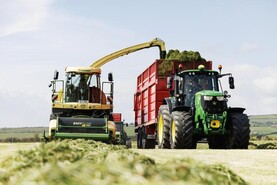The silage season is one of the busiest times in the Irish farming calendar. By its nature, contracting follows the same type of work, so it too deserves the unfortunate title. On this page, we give a few silage season pointers for contractors to make their lives and those of the people around them safer.
1) Slow down
The pressure might be on to get through work, but slow down. This not only applies to tractor drivers, but to all aspects of silage making.
If a machine gets blocked or clogged, wait for it to come to a complete stop. Turn off the engine and the tractor’s PTO. Apply the handbrake before you leave the cab. Always carry a mobile phone with you if you are working alone.
2) Overhead wires
Whether it’s driving a forage harvester, tractor and silage trailer or loader, contractors and farmers need to pay attention to overhead wires. These can easily get caught in machinery with devastating consequences.
When you reach a new farm job, take time to check out where you are about to work and see where the ESB wires are. If in doubt, contact the ESB on 1850 372 999.
3) Silage pit height
Increased cow numbers have not resulted in bigger silage pits. In a lot of cases, contractors are expected to put a lot more acres of silage into an area of concrete designed for far less. These higher pits often mean that loader drivers are working on unstable surfaces at heights upwards of 9m (30ft).
4) Tractor and trailer brakes
All tractor and trailer brakes should be functioning properly. Farmers and contractors should take time before the start of the season to inspect them and repair or replace any worn parts. Check the amount of material left on the brake pads of your trailer. If in doubt, ask a trailer technician to inspect them and, if required, replace them. Remember, having properly working trailer brakes will potentially save hundreds of euros in repairs.
5) Tractor mirrors and rotating beacon
As simple as it sounds, these need to be in place and working for travelling on a public road. Mirrors make your life, and those of other motorists, safer as you can pull in to allow traffic to pass at a safe point of the road. Rotating beacons alert other road users to your presence, so they can reduce their speed and pull in to allow you to pass.






 This is a subscriber-only article
This is a subscriber-only article










SHARING OPTIONS: